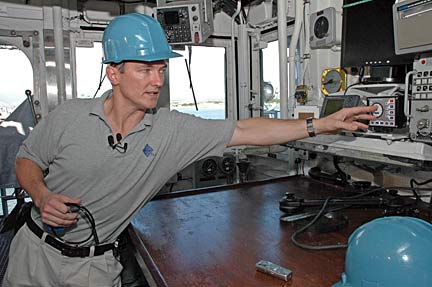Petty officer aboard the USS Crommelin, on the need for radio transmitters at sea

|
No sailor left behind
Navy sailors will receive
tracking devices to help rescue
those who fall overboard
Since 1988 about 60 sailors each year fall off a Navy vessel at sea. Most of them are easily rescued, but the operation can become a nightmare if the sailor is lost at night.
"In the daytime we can easily see him and pick him up," said Petty Officer Daniel Roberts, who has been in the Navy for 15 years, the last three on the Pearl Harbor-based frigate USS Crommelin. "It's too dark at night, and sometimes we may never realize he is gone until the next morning."
All that is changing with something the Navy calls the Man Overboard Identification system being installed in all Navy ships.
At $200 per unit, the Navy wants to outfit every sailor in the Pacific Fleet with a radio transmitter the size of pager attached to his float coat or life vest.
Chuck Collins, director of operations for Briar Tek, which is installing the system, said the transmitter is automatically activated if it is immersed in salt water for longer than three seconds. Powered by a 9-volt battery, the transmitter also can be activated manually.
The range of the signal can be as far as 23 miles, depending on sea conditions, Collins said. The small blue transmitter can keep sending a signal for 36 hours.

Chuck Collins, civilian contractor for Briar Tek Inc., adjusted the radio direction finder on the bridge of the Crommelin. The device will help the ship locate sailors.
The Pearl Harbor-based frigates Crommelin and USS Reuben James are the first to be outfitted in the Pacific Fleet. Outfitting all the ships assigned to Pearl Harbor is expected to take three years. Permanent installation on other Navy ships began late last year.
Collins said the Navy began field-testing the new system in 2002, although it has been used commercially since 1999.
Twenty ships, including the USS George Washington and the USS Abraham Lincoln carrier groups, were involved in the tests, Collins said.
"During the evaluation on the Lincoln, a sailor was blown off the flight deck at night and was rescued about 20 minutes later," he said.
Collins said such a system is vital on a busy place like the flight deck of an aircraft carrier, where there is much activity going on at one time and where a sailor's disappearance would go unnoticed.
[News] [Business] [Features] [Sports] [Editorial] [Do It Electric!]
[Classified Ads] [Search] [Subscribe] [Info] [Letter to Editor]
[Feedback]
